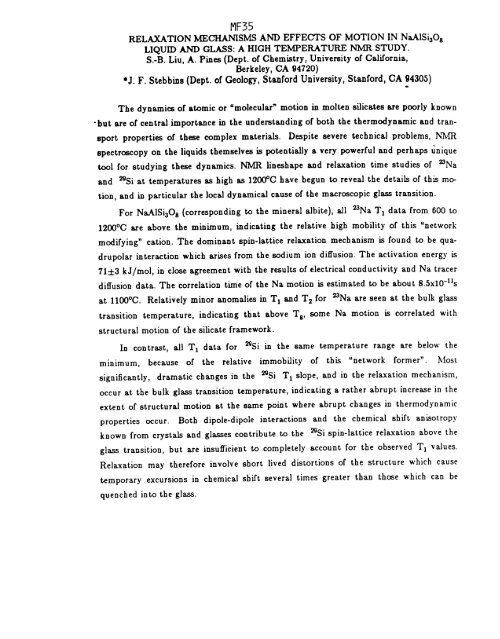th - 1987 - 51st ENC Conference
th - 1987 - 51st ENC Conference
th - 1987 - 51st ENC Conference
Create successful ePaper yourself
Turn your PDF publications into a flip-book with our unique Google optimized e-Paper software.
MF35<br />
RELAXATION MECHANISMS AND EFFECTS OF MOTION IN NaAISi30 s<br />
LIQUID AND GLASS: A HIGH TEMPERATURE NMR STUDY.<br />
S.-B. Liu, A. Pines (Dept. of Chemistry, University of California,<br />
Berkeley, CA 94720)<br />
*J. F. Stebbins (Dept. of Geology, Stanford University, Stanford, CA 94305)<br />
The dynamics of atomic or "molecular" motion in molten silicates are poorly known<br />
"but are of central importance in <strong>th</strong>e understanding of bo<strong>th</strong> <strong>th</strong>e <strong>th</strong>ermodynamic and tran-<br />
sport properties of <strong>th</strong>ese complex materials. Despite severe technical problems, l~%,I~R<br />
spectroscopy on <strong>th</strong>e liquids <strong>th</strong>emselves is potentially a very powerful and perhaps unique<br />
tool for studying <strong>th</strong>ese dynamics. NMR lineshape mad relaxation time studies of 23Na<br />
and ~Si at temperatures as high as 1200°C have begun to reveal <strong>th</strong>e details of <strong>th</strong>is mo-<br />
tion, and in particular <strong>th</strong>e local dynamical cause of <strong>th</strong>e macroscopic glass transition.<br />
For NaA1Si30 s (corresponding to <strong>th</strong>e mineral albite), all 23Na T 1 data from 600 to<br />
1200°C are above <strong>th</strong>e minimum, indicating <strong>th</strong>e relative high mobility of <strong>th</strong>is "network<br />
modifying" cation. The dominant spin-lattice relaxation mechanism is found to be qua-<br />
drupolar interaction which arises from <strong>th</strong>e sodium ion diffusion. The activation energy is<br />
71-1-3 k J/tool, in close agreement wi<strong>th</strong> <strong>th</strong>e results of electrical conductivity and Na tracer<br />
diffusion data. The correlation time of <strong>th</strong>e Na motion is estimated to be about 8.5x10-11s<br />
at 1100°C. Relatively minor anomalies in T 1 and T 2 for 23Na are seen at <strong>th</strong>e bulk glass<br />
transition temperature, indicating <strong>th</strong>at above T s, some Na motion is correlated wi<strong>th</strong><br />
structural motion of <strong>th</strong>e silicate framework.<br />
In contrast, all T 1 data for 2gSi in <strong>th</strong>e same temperature range are below <strong>th</strong>e<br />
minimum, because of <strong>th</strong>e relative immobility of <strong>th</strong>is "network former". Most<br />
significantly, dramatic changes in <strong>th</strong>e ~Si T 1 slope, and in <strong>th</strong>e relaxation mechanism,<br />
occur at <strong>th</strong>e bulk glass transition temperature, indicating a ra<strong>th</strong>er abrupt increase in <strong>th</strong>e<br />
extent of structural motion at <strong>th</strong>e same point where abrupt changes in <strong>th</strong>ermodynamic<br />
properties occur. Bo<strong>th</strong> dipole-dipole interactions and <strong>th</strong>e chemical shift anisotropy<br />
known from crystals and glasses contribute to <strong>th</strong>e 2QSi spin-lattice relaxation above <strong>th</strong>e<br />
glass transition, but are insufficient to completely account for <strong>th</strong>e observed T 1 values.<br />
Relaxation may <strong>th</strong>erefore involve short lived distortions of <strong>th</strong>e structure which cause<br />
temporary excursions in chemical shift several times greater <strong>th</strong>an <strong>th</strong>ose which can be<br />
quenched into <strong>th</strong>e glass.













